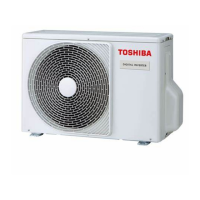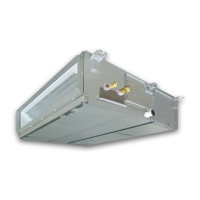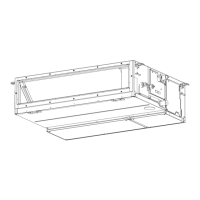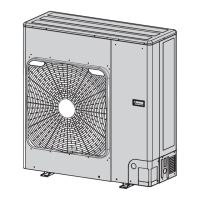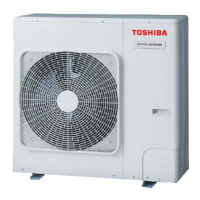What does 'TL sensor error' mean for Toshiba RAV-GM901CTP-E Air Conditioner?
- CCurtis HessSep 14, 2025
If your Toshiba Air Conditioner displays 'TL sensor error', it means that the TL sensor may be displaced, disconnected, or short-circuited.
What does 'TL sensor error' mean for Toshiba RAV-GM901CTP-E Air Conditioner?
If your Toshiba Air Conditioner displays 'TL sensor error', it means that the TL sensor may be displaced, disconnected, or short-circuited.
What to do if Toshiba RAV-GM901CTP-E Air Conditioner shows open phase detected?
If your Toshiba Air Conditioner indicates an open phase, check the power supply and voltages, as the power wire may be connected incorrectly.
Why is my Toshiba RAV-GM901CTP-E showing a duplicated header remote controllers error?
This error with your Toshiba Air Conditioner arises because two remote controllers are set as header in the double-remote controller control. This is due to a remote controller address setting error.
What does it mean if my Toshiba RAV-GM901CTP-E Air Conditioner displays duplicated indoor addresses?
The 'Duplicated indoor addresses' error on your Toshiba Air Conditioner means the same address as the self-address was detected. This is due to an indoor address setting error.
What does 'Indoor unit room temp. sensor (TA) error' mean for Toshiba Air Conditioner?
If your Toshiba Air Conditioner displays 'Indoor unit room temp. sensor (TA) error', it means that an open-circuit or short-circuit of the room temp. sensor (TA) was detected.
What does 'Case thermostat operation (1)' mean for Toshiba RAV-GM901CTP-E Air Conditioner?
If your Toshiba Air Conditioner displays 'Case thermostat operation (1)', it indicates a malfunction of the case thermostat.
What does 'Outdoor unit high-pressure system error' mean for Toshiba Air Conditioner?
The 'Outdoor unit high-pressure system error' in your Toshiba Air Conditioner means that the IOL was activated or an error was detected in the high-pressure releasing control using the TE.
What does 'Heat sink overheat' mean for Toshiba Air Conditioner?
The 'Heat sink overheat' error for your Toshiba Air Conditioner means that abnormal temperature was detected by the temp. sensor of the IGBT heat sink.
What does 'Outdoor unit inverter Idc activated' mean for Toshiba RAV-GM901CTP-E?
The 'Outdoor unit inverter Idc activated' error in your Toshiba Air Conditioner means that short-circuit protection for compressor drive circuit devices (G-Tr/IGBT) was activated.
What does 'Outdoor unit outside air temp. sensor error' mean for Toshiba RAV-GM901CTP-E?
If your Toshiba Air Conditioner displays 'Outdoor unit outside air temp. sensor error', it means there is an open-circuit or short-circuit of the outdoor air temp. sensor. Operation continued.
Essential safety rules and considerations for operating the air conditioner.
Precautions for safe transportation and storage of the air conditioner and its packaging.
Safety measures for installation, operation, repairs, and relocation of the unit.
Identification of components specific to the indoor unit.
Identification of components specific to the outdoor unit.
Explanation of the icons and displays on the remote controller.
Details on how to use the buttons and functions of the remote controller.
Steps for initial setup and requirements before operating the unit.
Instructions on selecting and starting different operation modes.
Specific instructions for using the 8°C heating operation feature.
How to set and manage the off timer and on timer functions.
How to adjust the horizontal and vertical airflow direction for optimal comfort.
Instructions for starting/stopping swing and adjusting horizontal airflow.
Steps to enable and configure the power saving mode for energy efficiency.
Procedure for cleaning the air filters to maintain performance.
Steps for preparing the unit for extended periods of non-use.
Actions to take before the cooling season begins.
Regular checks to ensure proper functioning and prevent issues.
Table of common symptoms and their potential causes for troubleshooting.
Checks to perform before starting the air conditioner operation.
How to check and confirm stored error logs for diagnostics.
Recommended and prohibited places for installing the air conditioner.
How to manage noise and vibrations during installation.
Key performance and physical characteristics of the air conditioner.
Essential safety rules and considerations for operating the air conditioner.
Precautions for safe transportation and storage of the air conditioner and its packaging.
Safety measures for installation, operation, repairs, and relocation of the unit.
Identification of components specific to the indoor unit.
Identification of components specific to the outdoor unit.
Explanation of the icons and displays on the remote controller.
Details on how to use the buttons and functions of the remote controller.
Steps for initial setup and requirements before operating the unit.
Instructions on selecting and starting different operation modes.
Specific instructions for using the 8°C heating operation feature.
How to set and manage the off timer and on timer functions.
How to adjust the horizontal and vertical airflow direction for optimal comfort.
Instructions for starting/stopping swing and adjusting horizontal airflow.
Steps to enable and configure the power saving mode for energy efficiency.
Procedure for cleaning the air filters to maintain performance.
Steps for preparing the unit for extended periods of non-use.
Actions to take before the cooling season begins.
Regular checks to ensure proper functioning and prevent issues.
Table of common symptoms and their potential causes for troubleshooting.
Checks to perform before starting the air conditioner operation.
How to check and confirm stored error logs for diagnostics.
Recommended and prohibited places for installing the air conditioner.
How to manage noise and vibrations during installation.
Key performance and physical characteristics of the air conditioner.
| Brand | Toshiba |
|---|---|
| Model | RAV-GM901CTP-E |
| Category | Air Conditioner |
| Language | English |

